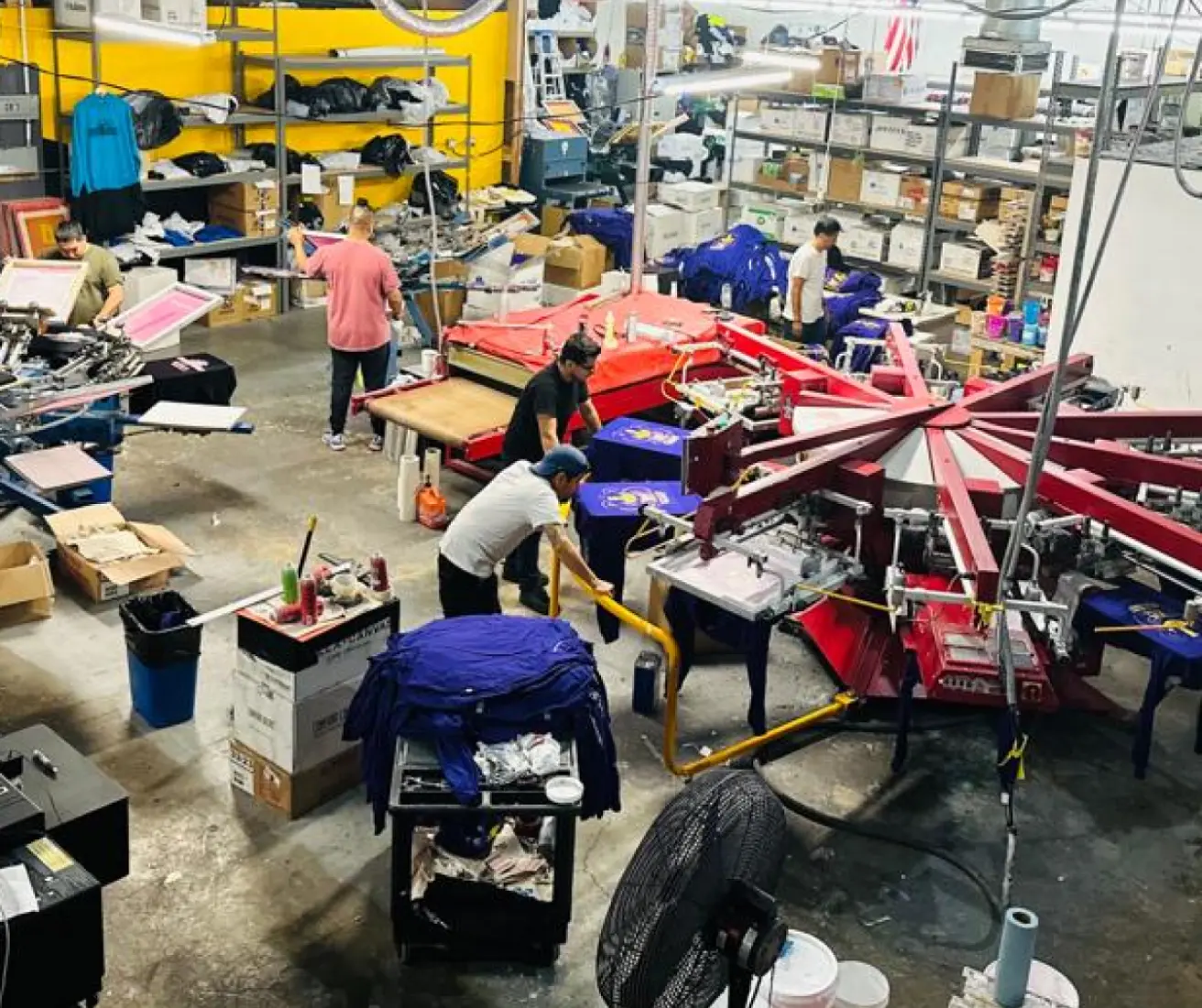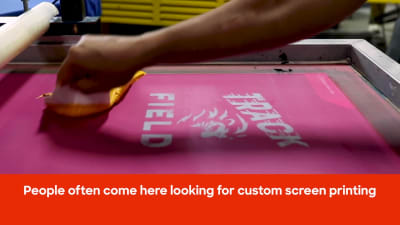Screen Printing Uncovered: Whatever You Required to Understand About Tee Shirt and Garment Printing Methods
Display printing is a fascinating technique that combines art with technique, providing unlimited opportunities for imagination. All set to explore the vital components that make display printing an art form?
The Fundamentals of Display Printing: How It Functions
When you dive into screen printing, you'll uncover it's both a scientific research and an art. At its core, display printing involves creating a pattern, or display, that enables ink to pass through only in details areas.
Position the screen over the material, after that utilize a squeegee to push ink with the display onto the garment. Each action is necessary, and understanding them will boost your screen printing skills, transforming simple garments into distinct, meaningful pieces.
Types of Display Printing Methods
When you grasp the essentials of screen printing, it's time to check out the different techniques that can boost your layouts. One popular method is typical screen printing, where ink is pushed via a stenciled display.
If you're going for fine information, take into consideration discharge printing. This method gets rid of color from the fabric, leaving a soft, vintage look. An additional option is plastisol printing, understood for its durability and vivid shades, making it a favored for many brands. Lastly, explore halftone printing to develop slope effects and complex layouts. Each technique has its special appeal, so do not think twice to attempt them out to find what fits your style best!
Important Tools for Screen Printing
To accomplish sensational outcomes in display printing, having the right equipment is basic. You'll need a durable screen printing framework, which holds the mesh that moves your layout onto the garment. Next, spend in high-quality squeegees; these are essential for applying ink equally across the screen.
Picking the Right Inks and Materials
When choosing inks and materials for screen printing, you require to consider the kind of ink that works finest for your job. Consider material compatibility to guarantee your designs look last and fantastic lengthy. Also, discover environmentally friendly ink alternatives to make your printing process a lot more lasting.
Types of Screen Inks
Choosing the ideal screen ink is important for achieving vibrant, long lasting prints that satisfy your task's demands. There are a number of kinds of screen inks to check out. Specialized inks, such as metallic or glow-in-the-dark, can add distinct results to your layouts.

Textile Compatibility Considerations
Understanding textile compatibility is essential for accomplishing top notch display prints, particularly because various materials respond uniquely to different inks. When choosing inks, think about the fabric type-- cotton, polyester, or blends. For cotton, water-based inks function well, using gentleness and breathability. Polyester, on the other hand, often calls for plastisol inks for far better attachment and vivid shades. If you're printing on blends, you might need to use a mix of both types. Constantly check your inks on sample fabric to ensure they adhere properly and keep color integrity. In addition, bear in mind that fabric weight and texture can impact the last outcome, so picking the best ink and product combination is crucial for your job's success.
Eco-Friendly Ink Options
Green inks are ending up being a popular choice for screen printers that want to reduce their environmental impact while preserving quality. When picking inks, think about water-based inks, which are less dangerous and much easier to clean up compared to traditional solvents.
Additionally, search for inks made from renewable energies, such as soy or vegetable-based options. By picking the right inks and products, you'll not only produce stunning designs but likewise contribute to a much more sustainable printing process. Make the switch, and your prints will reflect your commitment to the environment!
Preparing Your Design for Screen Printing

Submit Style Demands
To ensure your style looks dynamic and sharp on fabric, you'll require to pay attention to submit format requirements for screen printing. Beginning with vector documents like AI or EPS, as they can be scaled without shedding quality. If you use raster pictures, go with high-resolution files, such as TIFF or PNG, ideally at 300 DPI. Avoid utilizing JPEGs, as they can lose clarity when resized. Likewise, ensure your layout has a clear history to avoid unwanted white edges on your prints. Finally, maintain shade modes in mind; CMYK is typical for display printing, so transform your RGB develops as necessary. By adhering to these guidelines, you'll establish your art work up for a successful print.
Shade Splitting Up Techniques
Color separation is a vital action in preparing your layout for screen printing, and understanding it can greatly boost your print high quality. You'll need to damage your design right into private Go Here colors, as each shade requires a different screen during printing. Start by determining all the shades in your layout and produce layers each. You can utilize software application like Adobe Photoshop or Illustrator to separate and separate colors effectively. Be particular to conserve each layer as a different data, generally in a layout like TIFF or PSD. This accuracy not just ensures accurate shade representation however also simplifies the printing process. By taking notice of shade separation, you'll accomplish professional and vivid cause your screen-printed garments.
Resolution and Dimension
Attaining the very best results in screen printing begins with assuring your design has the ideal resolution and dimension. Preferably, your art work must be at the very least 300 DPI (dots per inch) for sharp, clear prints. If you utilize reduced resolution, your end product might look less than professional and pixelated.
When it pertains to dimension, consider the measurements of your print area. Style your art work to match the final print size, preferably developing it in the actual measurements you'll be printing. This way, you'll prevent any kind of unforeseen scaling issues.
Always examine your style in both vector and raster styles. Vector graphics can be scaled without losing top quality, making them optimal for screen printing. Preparing correctly will guarantee your layout looks fantastic on every garment!
Step-by-Step Display Printing Refine
Screen printing is a vibrant procedure that permits you to produce vibrant designs on various surfaces. To get begun, you'll need a display, emulsion, and your chosen ink.
Put ink onto the display and make use of a squeegee to press the ink via the pattern onto the textile. Raise the screen carefully and let the print dry. You have actually effectively screen published your style.
Tips for Successful Screen Printing Projects
While you're diving into your screen printing jobs, remember that prep work is key to success. Beginning by gathering all your materials-- inks, garments, squeegees, and screens. A clean workspace aids protect against unwanted mistakes, so clean up prior to you start.
Next, validate your artwork is high-resolution and correctly sized for your garment. Evaluate your display for proper direct exposure and tidy it thoroughly to avoid spots. When blending your inks, follow the manufacturer's guidelines to accomplish the best consistency.
During printing, apply even pressure with your squeegee for regular results. Don't hurry; take your time to confirm each print fulfills your criteria. After printing, allow your garments completely dry totally before dealing with or packaging them.
Lastly, always keep a sample of your help future reference. In this manner, you can evaluate your development and enhance your methods gradually. Delighted printing!

Frequently Asked Questions
The length of time Does It Require To Establish a Screen Printing Task?
Setting up a screen printing job normally takes around thirty minutes to an this contact form hour. You'll prepare the screens, mix inks, and readjust the press. The moment differs based on complexity and experience, so stay arranged!
Can I Publish on Different Material Keys In Using the Exact Same Technique?
Yes, you can print on different material kinds utilizing the same method, but you'll need to readjust your settings and inks. Some fabrics soak up ink in a different way, so experimenting guarantees the very best results for every product.
What Prevail Errors to Avoid in Display Printing?
When screen printing, avoid usual errors like making use of the incorrect ink, overlooking correct exposure times, or skipping pre-press checks. Always check your setup and maintain tidy screens to guarantee top quality results each time.
How Can I Properly Tidy and Keep My Display Printing Devices?
To correctly clean and maintain your screen printing devices, you need to on a regular basis wash displays view it now with proper solvents, inspect squeegees for wear, and ensure all tools are saved dry and dust-free. Uniformity boosts and avoids pricey repair work efficiency.
Is Screen Printing Eco Pleasant Contrasted to Various Other Methods?
Display printing can be a lot more eco-friendly than various other techniques, specifically if you utilize eco-conscious products and water-based inks. By choosing lasting supplies and methods, you minimize waste and lessen your influence on the earth.
Screen Printing Uncovered: Whatever You Required to Know Concerning T-Shirt and Garment Printing Methods
At its core, display printing entails producing a stencil, or display, that permits ink to pass via only in specific areas. Placement the display over the fabric, after that make use of a squeegee to push ink through the screen onto the garment. One popular method is typical screen printing, where ink is pushed with a stenciled display.When choosing inks and products for screen printing, you require to take into account the kind of ink that functions best for your project.